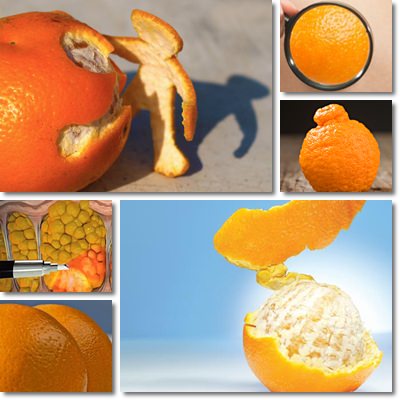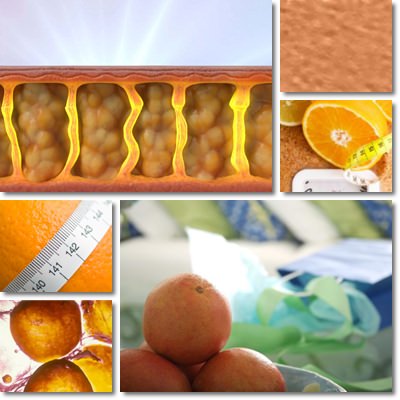Cellulite is probably one of the most dreaded physical imperfections for the modern woman. Yet it is a more common trait than we imagine as 85 to 95% of all women have it.
Cellulite is present in men as well as in women and, although undesirable, it has been found to be a normal physical trait.
Various factors may contribute to its development or cause it to become more visible or prominent. Nevertheless, cellulite in itself poses no health risks and is more of an aesthetics issue than a medical disorder.
What does cellulite look and feel like?
Cellulite is commonly called orange peel or orange peel syndrome because it makes the affected areas of our skin look and feel like the bumpy peel of an orange.
Skin with cellulite is dimpled and bumpy and has an overall loose, even fatty appearance. However, its appearance is misleading because there is usually only a normal, healthy amount of fatty tissue underneath the skin. It is just distributed differently.

What is cellulite actually?
Cellulite refers to a certain distribution of adipose tissue (fat) from underneath the skin in certain areas of our body. It is also called adiposis edematosa or orange peel syndrome and occurs when subcutaneous adipose tissue (fat from beneath the skin) pushes through the connective tissue, giving our skin an orange peel or bumpy, dimpled appearance.
Where is cellulite more likely to appear?
Cellulite is more likely to occur on the back, front, inner and outer skin of our thighs, bottom and abdomen, areas that tend to accumulate more fat than the rest of our body. However, it may be present on the arms, legs etc. While having extra weight can encourage its appearance, having a normal healthy weight or even a thin frame doesn’t exempt us from cellulite either.
What causes cellulite?
There are multiple factors that contribute to the development of cellulite, ranging from genetics to dietary habits and lifestyle choices. The causes most likely to lead to cellulite are:
1) Genetics
Thin, normal weight and overweight people may all develop cellulite. The condition appears indiscriminately in all ages, races, both genders, irrespective of occupation, geographical location and so on.
The wide distribution of orange peel skin has sparked great interest and has lead to the discovery of certain genes that make some of us prone to developing cellulite. So while other factors more in our reach may also contribute to what we deem unaesthetic skin, for many of us cellulite is a promise.

2) Hormones
The reason why women are more likely to develop cellulite is because female hormones, particularly estrogen, are considered to be directly involved in giving our skin its dimpled, orange peel aspect.
Other hormones such as insulin, adrenaline, noradrenaline or even thyroid hormones and prolactin are believed to play a role in cellulite development. However, more research is needed on the subject.
3) Bad lifestyle habits
Stress causes an increase in adrenaline and noradrenaline production and, as research suggests, both hormones may be linked to the development of cellulite in individuals without a genetic predisposition.
Sedentarism, the lack of physical exercises, favors fat deposits and bad circulation, encouraging cellulite to form. The reason why people who work out regularly don’t have orange peel skin is because exercise encourages good blood circulation and the burning of fat deposits, preventing the skin from becoming dimpled.
What is interesting is that people with extensive cellulite are advised by some experts to avoid running.
Apparently, running may cause the skin to go up and down and may lead to micro-injuries that may worsen skin aspect. However, staying active and working out in a more controlled manner is recommended.
4) Poor dietary choices
It’s common knowledge by now that a diet consisting of fatty foods, high-calorie foods and lots of sodium is bad for us.
Taking in too much calories, especially from the wrong foods encourages fat deposits to form, while a high salt intake causes water retention in the body. Both factors play a major role in the development of cellulite.
5) Body fat and weight
Too much body fat or excess weight means more fat deposits under the skin and a greater risk for cellulite. However, while severely overweight people do develop cellulite, this is not necessarily true for everyone with a few extra pounds. A slow metabolism may encourage it as well.
Other factors that may contribute to cellulite include:
1) Bad posture
Sitting with your legs crossed for long periods of time may have a negative impact on micro-circulation, hindering normal blood flow and possibly encouraging the development of cellulite. While good blood circulation helps dissolve fat deposits and may reduce cellulite risks, bad blood circulation may increase them.
2) Narrow clothing
Narrow clothing items such as jeans, trousers, skirts, blouses, shoes and so on inhibit normal blood circulation which puts more strain on our lymphatic system, making it work harder. And we need good blood and lymph circulation to be healthy and enjoy good looking skin.
3) Smoking and alcohol
Both cigarettes and alcoholic beverages have a vasoconstricting effect, making our blood vessels become narrower and limiting blood flow.
This effect on blood circulation may have a negative impact on skin health and appearance, potentially encouraging fatty deposits underneath the skin and their protruding into the connective tissue fibers, resulting in orange peel skin.
4) Stress
It has been suggested that chronic stress may influence our eating and lifestyle habits and contribute to cellulite formation.

Cellulite stages
There are usually four stages in the development of cellulite and they evolve as follows:
1) Stage 0: No cellulite is visible on the skin.
2) Stage 1: Skin preserves a smooth appearance, but pinching it or contracting our muscles reveals the first signs of cellulite.
3) Stage 2: The dimples or nodules are visible to the naked eye in some areas.
4) Stage 3: Cellulite may extend to a larger portion of the skin of the affected area and becomes more visible, even mildly painful.
Treatment options for cellulite
There is no real, 100% effective treatment for cellulite at the present. After all, there isn’t really anything to treat as cellulite is a normal aspect of our skin (it’s genetic for the most part).
However, preventing and improving skin aspect are both possible and require first and foremost good eating and a healthy, active lifestyle. Here are some good tips for dealing with cellulite:
1) Light physical exercise
Keeping active overall, doing aerobics or practicing other light forms of exercise can help prevent and improve the aspect of cellulite.
The earlier the stage, the better the results. The aim is to improve blood circulation and tone the body. This will not only help improve skin aspect, but also help prevent cellulite from advancing.
2) Avoid cigarette smoke and alcohol
Both smoking and alcohol consumption are known to have impact skin health negatively and cellulitis is a risk we may expose ourselves to if we smoke heavily or drink regularly. Excess coffee consumption may also be a contributing factor. Too much sugar, carbonated drinks and caffeinated beverages are also problematic.
3) Learn to avoid constipation
Going to the bathroom at least once a day is ideal if we want to feel good and be healthy because it helps us eliminate toxins and waste material from our body continuously.
4) Massage problematic areas
A gentle, but firm massage is a great way to improve blood circulation and encourage a healthy skin aspect. However, the bruise-causing cellulite massages promising to dislodge fat deposits risk injuring us and our skin and worsening its appearance.
5) Mesotherapy
This cosmetic, alternative therapy has been around for some time now, but it is only recently that it has started being used for cellulite treatment and many people have declared themselves satisfied with its results.
6) Laser therapy
Aiming to improve skin appearance, laser therapy may hold some benefits but results may differ from person to person with some people more satisfied than others.
Other treatment options promising to get rid of cellulite, cure or improve it include:
1) Cellulite creams
Topical creams of all sorts marketed to help improve skin firmness, reduce cellulite aspect and so on are often useless against it because there is really no compound or herb extract that would specifically target the fat deposits underneath our thigh, bottom or abdomen skin and melt them so we don’t have cellulite anymore.
Many such creams contain the same compounds found in certain medicines and may list side effects such as cardiovascular complications, allergies or anaphylactic shock.
2) Liposuction
Most women with cellulite feel that surgery is their last change at a young, firm and cellulite-free skin and save up in order to afford a liposuction.
However, liposuction cannot target the more superficial fat deposits that push into connective tissue, resulting in the bumps and dimples we call cellulite, but only deeper fat deposits, hence the reason why it is so often unsuccessful, not to mention it carries significant risks.
Conclusion
Smooth, clear and toned skin is one of the most desirable traits, yet very few people have it. Instead, most of us have bumpy, dimpled skin that somehow looks unaesthetic. And this is no reason to worry as it doesn’t affect our health in any way whatsoever, nor should it have an impact on our self esteem or self worth. Cellulite is a normal aspect of our skin and there is no reason to subject ourselves to expensive, useless or risky procedures to have it removed if there is no need to. Keeping active, eating and living right in order to achieve good health should be our goal, not worrying about orange peel skin and what others might think of it.
